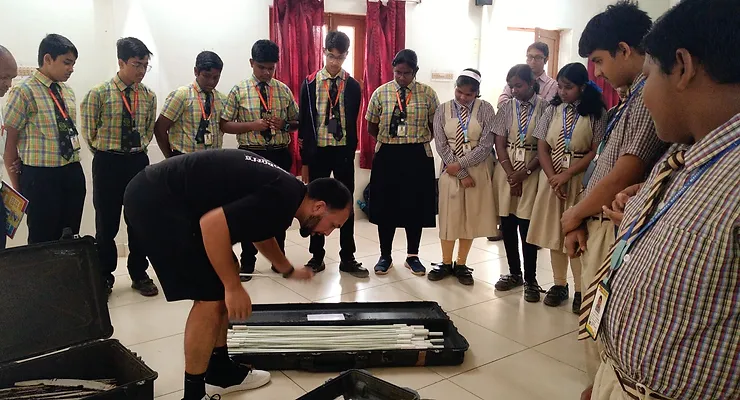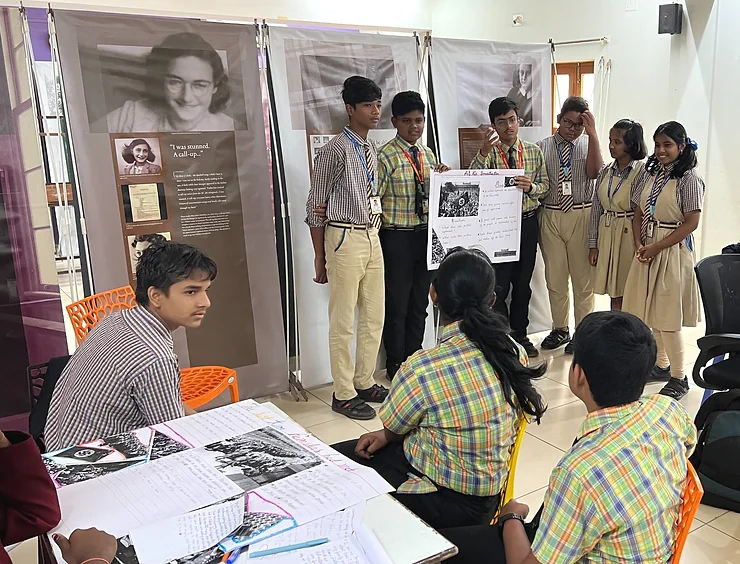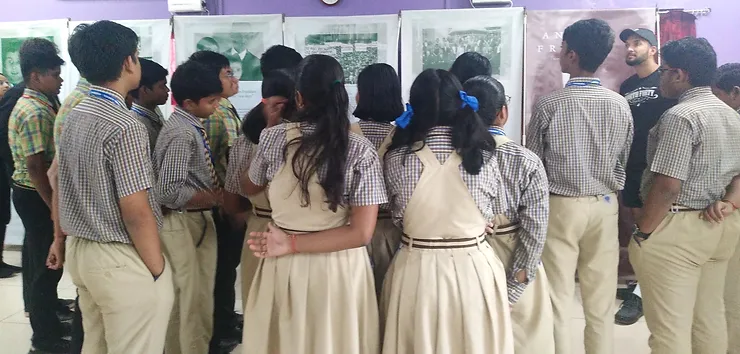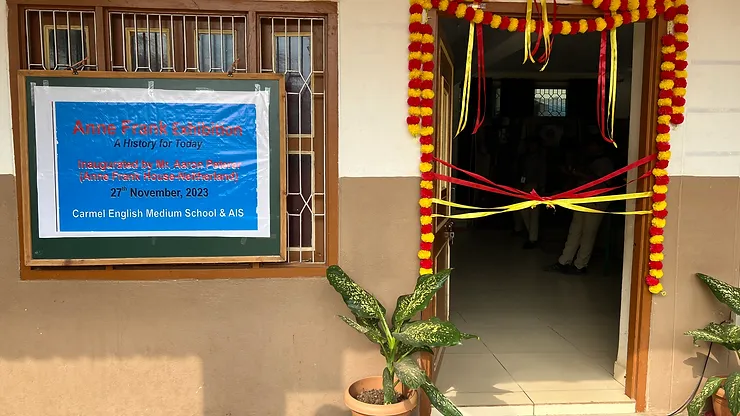Phase I
November 20-21, 2023
Goethe Institut / Max Mueller Bhavan, Kolkata
Winter in Calcutta was ushered in by a training of the trainers for the traveling exhibition on Anne Frank, an integral part of the Anne Frank—A History for Today project. This project is part of the educational activities run by the Anne Frank House, Amsterdam, The Netherlands, its India partner being PeaceWorks. The two-day training/workshop was held on November 20 and 21, 2023 at the Goethe Institut / Max Mueller Bhavan, Kolkata. The four volunteers—Somashree Choudhury, Srilagna Majumdar, Roshmi Dey and Urvi Shah of History for Peace were trained by Aaron Peterer to be peer guides to the exhibition, with a larger goal of taking forward the project in future and train more young adults to be peer guides and human rights defenders.

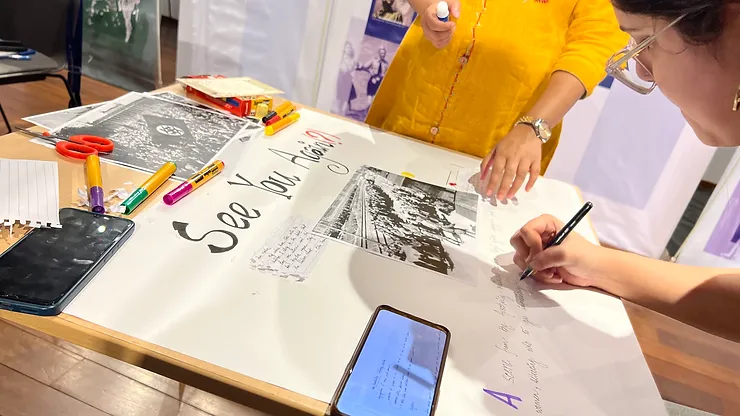
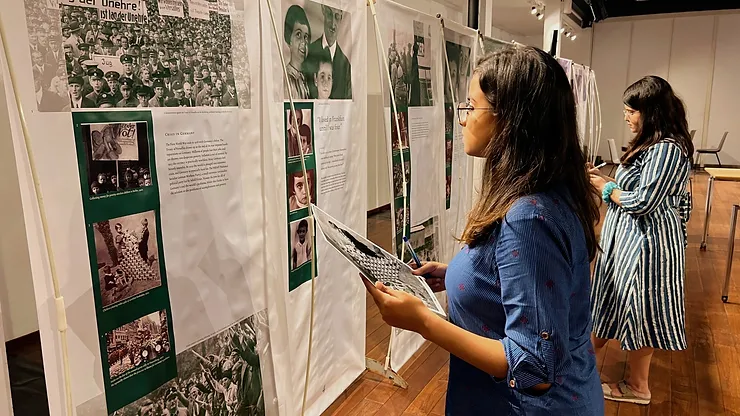 Both days were full of fun-filled, team-building activities, aimed at building communication and stirring up more interactions between unfamiliar people. This, in-turn, aided in the shedding of prejudices and biases, being relaxed and composed in unconventional situations, in addition to the central aim of gaining knowledge about the Second World War, Holocaust and Anne Frank, and addressing similar such situations of human rights violation that we see in our world today.
Both days were full of fun-filled, team-building activities, aimed at building communication and stirring up more interactions between unfamiliar people. This, in-turn, aided in the shedding of prejudices and biases, being relaxed and composed in unconventional situations, in addition to the central aim of gaining knowledge about the Second World War, Holocaust and Anne Frank, and addressing similar such situations of human rights violation that we see in our world today.
Phase II
November 25-27, 2023
Carmel English Medium School, Khordha
Peer Guide Training and Workshop: November 25-26, 2023
In association with the Goethe Institut / Max Mueller Bhavan, Kolkata, The Anne Frank exhibition, then, traveled to Bhubaneswar, the host being Carmel English Medium School, Khordha. The exhibition opened on November 27, 2023, and was preceded by the two-day training of peer guides on November 25 and 26. Middle and high school students from Carmel English Medium School and Asha International School participated in the training. After a warm welcome by the school authorities, each student showed their best dance move in the introductory ice-breaking session. Similar to the training of trainers, all activities were meant to build communication skills and teamwork, resulting in the formation of a safe space for the students and trainers alike.
This was followed by a name-game, and then, the students were taught to assemble the frame of exhibition panels from scratch. After putting together 32 frames, a discussion ensued as to what the layout of the exhibition would be to adjust to the space given. Next, the exhibition was set up and students were encouraged to go through it. They were each given index cards to write down three questions they had in mind about Anne Frank or the exhibition in general. This was succeeded by an examination of the components of the panels: texts, images, layout, structure and topic.
 A discussion on Anne Frank ensued, during which the students wrote snippets of information already known to them on a flip chart sheet. Responses from the students varied from Anne Frank’s birthplace to hiding place, her friends and love interest, names of concentration camps, and most importantly, her diary.
A discussion on Anne Frank ensued, during which the students wrote snippets of information already known to them on a flip chart sheet. Responses from the students varied from Anne Frank’s birthplace to hiding place, her friends and love interest, names of concentration camps, and most importantly, her diary.
 Post lunch, the documentary titled, The Short Life of Anne Frank was shown and the students were called upon to offer their reflections on it, emphasizing on the aspect—from the film or Anne Frank’s life—that moved them the most. This was followed by the last activity of the day on the Best Educational Image, for which students were randomly divided into multiple groups. Trainers provided the students with photocopies of images from the exhibition and asked to locate and study them from the panels. Then each group zeroed in on one image and noted down on flip chart sheets what the image was about, why they chose it and a few questions on the image for the other groups to answer. They were free to paste the image and decorate their chart sheets as they wished. Each group, then, presented their image to the others. This activity showed the trainees how to make their own exhibition panel. This activity continued on the second day.
Post lunch, the documentary titled, The Short Life of Anne Frank was shown and the students were called upon to offer their reflections on it, emphasizing on the aspect—from the film or Anne Frank’s life—that moved them the most. This was followed by the last activity of the day on the Best Educational Image, for which students were randomly divided into multiple groups. Trainers provided the students with photocopies of images from the exhibition and asked to locate and study them from the panels. Then each group zeroed in on one image and noted down on flip chart sheets what the image was about, why they chose it and a few questions on the image for the other groups to answer. They were free to paste the image and decorate their chart sheets as they wished. Each group, then, presented their image to the others. This activity showed the trainees how to make their own exhibition panel. This activity continued on the second day.
After reflections of Day One and providing each other with constructive feedback on the group presentations, Day Two continued with another documentary titled, Eyewitnesses. Topics such as the importance, and pros and cons of helping those in trouble were discussed elaborately, within the context of the film and otherwise.
Next, the students were regrouped and each group was given a range of the panels, from which they had to choose and study any one. The next step was to take the other group members and the trainers around for a guided walk through the exhibition, explaining the context and meaning of each panel. This activity gave them first-hand experience of how to show around an exhibition when visitors arrive to view it. The students were encouraged to ask questions to the presenters, comment on their speaking skills and suggest improvizations if and when required. Vital deliberations ensued regarding historical vignettes on race laws, oppression, fascism, rise of Hitler and the NSDAP, persecution of Jews and other racial minorities—the Blacks, Roma gypsies, and homosexual and handicapped people, and so on. All other activities were related to guiding through the exhibition, as by now, the students had been trained to be peer guides. These included discussing the aims and background of the exhibition, each guide assigning themselves three panels for explanation to visitors, and the Red Thread activity in which each guide was asked to choose any 20 related images from all 32 panels which can be joined by an imaginary red thread, so as to club the most appealing and intriguing images while guiding.
The day concluded with finding answers to the three questions the peer guides had written down at the beginning of their training on Day One. Most of them were answered by the peer guides themselves, now that they were thorough with the entire exhibition. They were also asked to reflect on acts of discrimination, violence and injustice they have witnessed and/or faced in real life, or similar such incidents pertaining to present times. They shared their opinions and feedback about the training, declaring that the sessions were not just informational but interactive, and beyond their expectations.
Opening of the Exhibition: November 27, 2023
The exhibition was opened ceremoniously the Carmel English Medium School, in the presence of the Principal, President and Founder-Secretary of the school, along with few other invited guests and dignitaries. Despite being a state holiday, students from the school and others poured in in huge numbers. The peer guides deftly handled questions and queries, successfully guiding the visitors through the exhibition. The newly trained peer guides claimed that they looked forward to more such activities in future.



